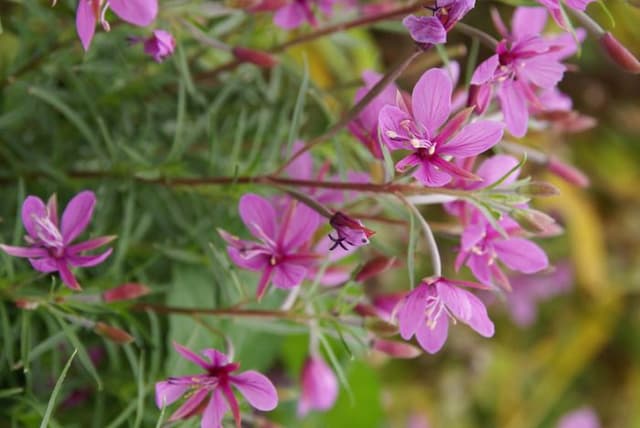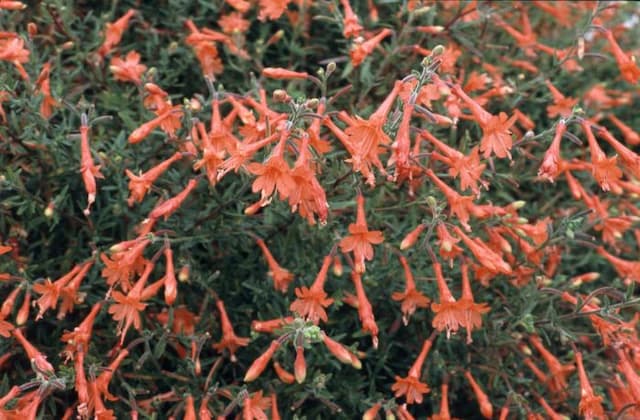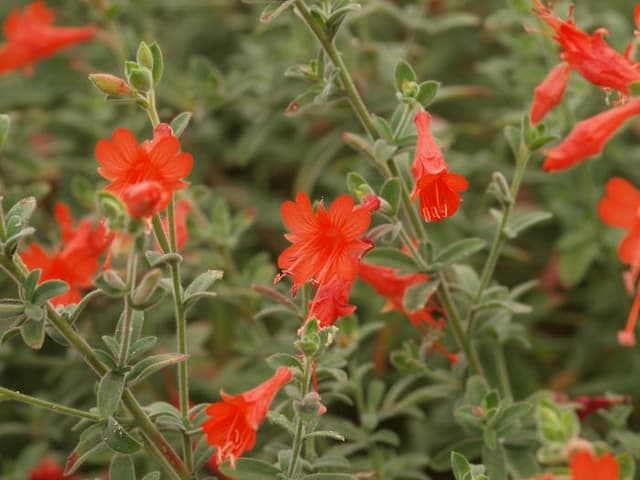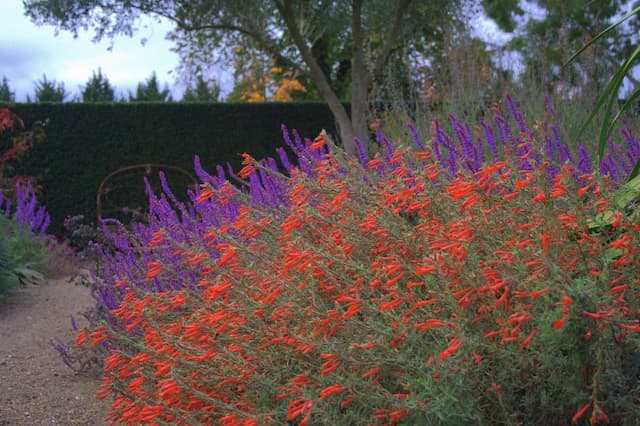Fuchsia Fuchsia 'Alan Titchmarsh'

ABOUT
Fuchsia 'Alan Titchmarsh' is a beautiful ornamental plant known for its striking appearance. This plant is adorned with delightful hanging flowers that are a surefire attention-grabber in any garden. The flowers boast an elegant combination of colors, typically with outer petals that shade from pink to light purple hues, creating a soft, inviting palette. These outer petals gracefully surround inner petals that typically take on a much deeper purple or even rich magenta coloration, adding a dramatic contrast to the flowering display. The blossoms of 'Alan Titchmarsh' commonly feature long, slender, and sometimes slightly curved tubes that emerge from the center of the petals, tipped with reproductive structures that are often brightly colored and add further intricacy to the overall floral arrangement. The blooms dangle delicately, often in clusters, from slightly arching stems, which can create a cascading effect that is especially stunning when the plant is placed in a hanging basket or on an elevated surface where the full elegance of its drooping blossoms can be admired. Adding to the charm of the 'Alan Titchmarsh' are its leaves that create a lush backdrop for its blossoms. The foliage is typically green, though it can vary in shade from light to dark, and is characterized by a slightly glossy texture that can catch the light, lending a vibrancy to the plant's appearance. The leaves are usually oval-shaped with softly serrated edges, providing a nice texture contrast to the smoothness of the petals. Overall, the Fuchsia 'Alan Titchmarsh' is a captivating and showy plant that can bring a burst of floral beauty and an air of sophistication to garden settings, hanging arrangements, and balcony displays with its gorgeous, pendulous flowers and attractive green foliage.
About this plant
 Names
NamesFamily
Onagraceae
Synonyms
Lady's Eardrops, Fairy Bells, Hummingbird Fuchsia
Common names
Fuchsia 'Alan Titchmarsh'.
 Toxicity
ToxicityTo humans
Fuchsias, including the 'Alan Titchmarsh' variety, are generally considered non-toxic to humans. They are not known to cause serious symptoms of poisoning if ingested. However, ingestion of non-edible plants can sometimes cause mild gastrointestinal discomfort due to the novelty of the plant matter in the digestive system.
To pets
Fuchsias, including the 'Alan Titchmarsh' variety, are not commonly listed as toxic to pets. These plants are generally considered safe for pets, and there is no widespread documentation of toxicity in animals such as dogs and cats. If a pet were to ingest parts of a fuchsia plant, they might experience mild gastrointestinal upset, but significant toxicity is not expected.
 Characteristics
CharacteristicsLife cycle
Perennials
Foliage type
Deciduous
Color of leaves
Green
Flower color
Mixed
Height
1-2 feet (30-60 cm)
Spread
1-2 feet (30-60 cm)
Plant type
Shrub
Hardiness zones
9
Native area
Central America
Benefits
 General Benefits
General Benefits- Attractive Flowers: Fuchsia 'Alan Titchmarsh' produces vibrant, pendulous flowers that are visually appealing and can brighten up any garden.
- Long Flowering Period: This cultivar often has a lengthy blooming season, providing color and interest in the garden for an extended time.
- Hummingbird Magnet: The flowers of the fuchsia plant are known to attract hummingbirds, providing a delightful sight for gardeners and nature lovers.
- Versatility: Fuchsia 'Alan Titchmarsh' can be grown in hanging baskets, containers, or borders, making it versatile for different garden designs.
- Shade Tolerance: Unlike many flowering plants, fuchsias can thrive in partial shade, offering a great option for less sunny spots in the garden.
- Easy to Propagate: Fuchsias can be easily propagated from cuttings, allowing gardeners to create new plants and expand their collection without additional cost.
- Garden Focal Point: With its distinctive flowers and growth habit, fuchsia plants can serve as an eye-catching focal point in a garden setting.
 Medical Properties
Medical PropertiesThis plant is not used for medical purposes.
 Air-purifying Qualities
Air-purifying QualitiesThis plant is not specifically known for air purifying qualities.
 Other Uses
Other Uses- Dye Production: The berries of a Fuchsia plant can be used to create a purple dye for fabrics or inks.
- Garden Art: Trained into topiaries or standards, Fuchsia plants can serve as living artistic features in a garden.
- Educational Tool: Fuchsia plants can be used to teach botany and horticulture, particularly to demonstrate pollination and the growth habits of ornamental plants.
- Hummingbird Attractor: Fuchsia plants are known to attract hummingbirds, making them useful for those wanting to observe these birds or to enhance pollination in the garden.
- Photography Object: The vibrant colors and unique shape of Fuchsias make them excellent subjects for botanical photography.
- Floral Arrangements: Fuchsia flowers can be incorporated into bouquets and floral displays for their striking appearance.
- Culinary Garnish: Although more commonly known for other species, some Fuchsia flowers are edible and can be used as a decorative, colorful garnish in culinary presentations.
- Ephemeral Jewelry: The delicate flowers can be used to make temporary jewelry, such as earrings or hairpieces, for special events.
- Fairy Gardens: Due to their whimsical appearance, Fuchsia plants are often used to create fairy gardens, which are miniature and magical-themed garden arrangements.
- Craft Projects: The flowers and leaves of the Fuchsia can be pressed and used in craft projects, such as handmade paper or greeting cards.
Interesting Facts
 Feng Shui
Feng ShuiThe Fuchsia is not used in Feng Shui practice.
 Zodiac Sign Compitability
Zodiac Sign CompitabilityThe Fuchsia is not used in astrology practice.
 Plant Symbolism
Plant Symbolism- Grace: Fuchsias, with their delicate, teardrop-shaped flowers, often symbolize grace and elegance due to their unique and poised appearance.
- Confiding Love: They are sometimes associated with confiding love, reflecting the way the flowers seem to gently open up and dangle vulnerably.
- Good Taste: The vibrant, yet sophisticated color palette of the Fuchsia 'Alan Titchmarsh' can represent good taste, making it a symbol for those who appreciate beauty and refinement.
- Ardent Affection: The plant's fullness and prolific blooms can signify deep and passionate attachment, often expressing overflowing emotion.
- Harmony: The way that fuchsias bring together bold colors and delicate flowers may symbolize a harmonious balance in relationships or life.
- Trust in Friendship: Given as a gift, fuchsias can suggest trust and confidence within a platonic relationship.
- Amiability: The friendly appearance of the plant suggests warmth, congeniality, and approachability among people.
 Water
WaterFor your Fuchsia, also known as Lady's Eardrops, water thoroughly whenever the top inch of soil feels dry to the touch, which generally equates to about once or twice a week during the growing season. During the hotter months, this may increase to every few days to maintain consistent soil moisture, as Fuchsias prefer consistently moist but not soggy conditions. In terms of volume, for a typical potted Lady's Eardrops, you may need to use approximately 16-32 ounces of water per watering session, depending on the size of the pot and the environmental conditions. During winter or cooler months, water less frequently, just enough to prevent the soil from drying out completely.
 Light
LightLady's Eardrops thrive best in bright, indirect light with protection from intense afternoon sun. A spot that receives morning sunlight with dappled shade in the afternoon is ideal. If growing indoors, placing your Lady's Eardrops near a window where it can receive filtered light throughout the day will ensure it gets the appropriate amount of light without being scorched by the direct sun.
 Temperature
TemperatureLady's Eardrops prefer a temperate climate with temperatures ranging from 50 to 75 degrees Fahrenheit for optimum growth; they can struggle when temperatures drop below 40 degrees or rise above 80 degrees Fahrenheit. The ideal growing condition for Lady's Eardrops is a consistently maintained temperature within this range, without sudden fluctuations.
 Pruning
PruningPruning your Lady's Eardrops is important to encourage a bushier growth habit and more blooms. It's best to prune in late winter or early spring before new growth begins. Cut back the previous year's growth by about a third to promote strong, healthy stems. Additionally, deadheading spent flowers throughout the growing season will also encourage further blooming.
 Cleaning
CleaningAs needed
 Soil
SoilFor Fuchsia 'Alan Titchmarsh', a soil mix rich in organic matter with good drainage is best. Equal parts of peat moss, loam, and sand or perlite create an ideal environment. The soil pH should be moderately acidic, around 6.0 to 7.0, for optimal growth.
 Repotting
RepottingFuchsia 'Alan Titchmarsh' should be repotted annually, preferably in the spring. These plants have a fast growth rate and can quickly become root-bound in containers, necessitating regular repotting to maintain health and vigor.
 Humidity & Misting
Humidity & MistingFuchsia 'Alan Titchmarsh' thrives in moderate to high humidity levels. They perform best when the humidity is around 60-70%, which mimics their native environments.
 Suitable locations
Suitable locationsIndoor
Place in bright, indirect light and keep soil moist.
Outdoor
Partial shade, sheltered from wind, well-drained soil.
Hardiness zone
9-11 USDA
 Life cycle
Life cycleThe Fuchsia 'Alan Titchmarsh' starts its life as a seed, requiring a warm, moist environment to germinate, which takes about 21 days. As a seedling, it develops true leaves and begins to establish a root system. As it enters the vegetative stage, it grows stems and foliage, preferring partial shade and regular watering. The plant soon matures and enters the flowering stage, producing distinctive pendulous flowers, typically from late spring to fall. After pollination, it sets small fruits which contain seeds, thus completing its reproductive cycle. During winter or in very cold climates, the plant may become dormant, losing leaves and slowing growth until conditions are favorable again.
 Propogation
PropogationPropogation time
Mid-Spring to Early Summer
The Fuchsia 'Alan Titchmarsh', commonly known as Fuchsia, can be propagated most effectively through softwood cuttings. This method is generally undertaken in late spring to early summer when the plant is actively growing. To propagate, a healthy non-flowering shoot is selected and a cutting of about 3 to 4 inches (approximately 7.6 to 10 centimeters) is taken. The lower leaves are removed, and the cut end is dipped in a rooting hormone to encourage root development. The cutting is then planted in a mix of peat and perlite or a similar free-draining propagation medium. The container with the cutting should be kept under high humidity, either by placing it in a propagator or by covering it with a plastic bag, and kept in indirect light until roots have formed, which usually takes a few weeks. Once rooted, the new Fuchsia plant can be gradually acclimated to normal conditions and eventually transplanted to a larger pot or garden location.









